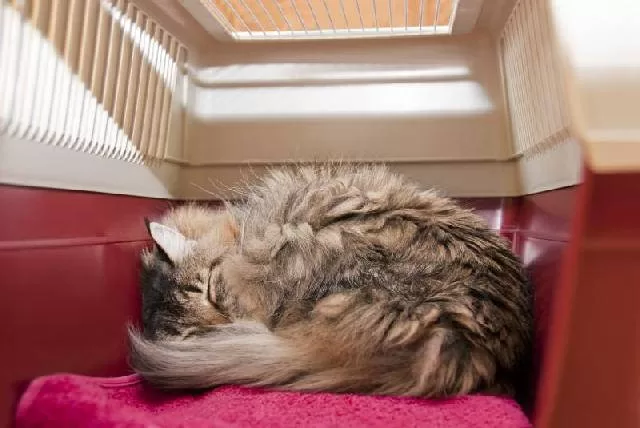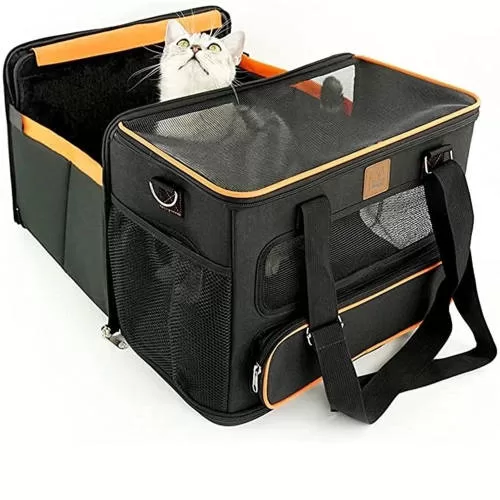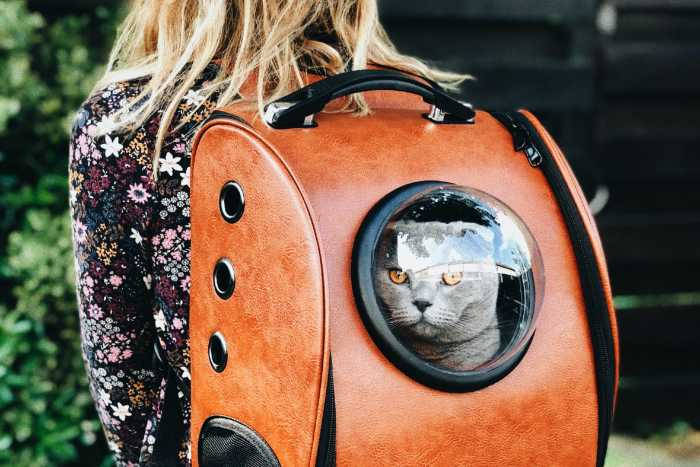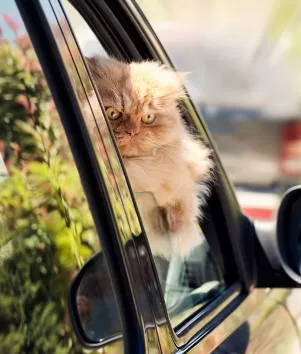In the article “Cats and Cars: How to Transport Safely”, we will discuss best practices to ensure a safe and comfortable journey for cats during transport in vehicles. It is essential to take care of the well-being of our felines during car trips, taking their needs into account and providing a safe and peaceful environment for them.
Main points of the article:
- The importance of using a suitable transport box to house your cat in the car;
- Brazilian Traffic Code regulations for transporting animals in vehicles ;
- How to choose the ideal transport box for your cat;
- Tips for preparing the cat for the transport box;
- Care to make the journey more comfortable for the cat;
- Safety tips to ensure your cat’s protection during travel;
- Identification of the cat during the trip and additional care to be taken;
- Maintaining adequate temperature inside the vehicle;
- Special care on long trips and additional precautions;
- Additional Resources and Conclusion on Safely Transporting Cats in Cars .
Regulations for transporting animals in vehicles
The transport of animals in vehicles is regulated by the Brazilian Traffic Code (CTB), and it is essential to know and follow these rules when transporting cats in the car. The CTB establishes specific rules to ensure animal safety and avoid infractions and penalties for drivers.

According to the CTB, it is mandatory to use suitable transport boxes or bags to accommodate the cat inside the vehicle. Transporting the animal loose or outside of these containers is considered irregular and dangerous, as it can distract the driver and put the safety of everyone in the car at risk.
Furthermore, it is important that the transport box is of an appropriate size and has a good closing system to prevent leaks. It is recommended that the box be secured by the vehicle’s seat belt or using a seat belt suitable for animals. These measures ensure that the cat is properly protected during the journey.
| Infringement | Traffic ticket | Points on the driver’s license |
|---|---|---|
| Transport the animal outside the transport box | R$ 130.16 | 4 points |
| Transport the animal with its head out of the window or in any external part of the vehicle | R$ 195.23 | 5 points |
It is important to highlight that failure to comply with the rules established by the CTB can result in fines and the loss of points on the driver’s license. Therefore, it is essential to know and follow these regulations to ensure your cat’s safety and avoid legal problems.
Choosing the right transport box
Choosing the appropriate transport box is essential to ensure your cat’s safety and comfort during transport in the car. It is important to use an efficient transport box, with a good closing system to prevent leaks and ensure that the cat is protected inside the vehicle. Avoid boxes that have holes in the sides, as they can allow the animal to escape.
Furthermore, it is essential that the transport box is an adequate size so that the cat can sit comfortably. Make sure the animal can stand and turn around inside the box. Secure the box to the vehicle’s seat belt firmly to avoid sudden movements during travel.

To get your cat used to the carrier , it is recommended to start the process as soon as possible. Place some cloths, toys or snacks inside the box and leave it open so the cat can explore and become familiar with the space on a daily basis. This way, when the time comes to use it to travel, the animal will already be used to it and feel more comfortable.
Another important tip is to spray synthetic pheromones inside the box about 15 minutes before placing the cat. Pheromones help minimize the animal’s stress during transport. Furthermore, it is advisable to have absorbent mats inside the box, as the stress of travel can cause some animals to urinate or have a bowel movement. Also avoid spending excessive or unnecessary time with the cat trapped in the box, only putting it in when you are about to leave the house.
| Tips for choosing the shipping box: |
|---|
| • Choose a box with a good closing system to prevent leaks; |
| • Make sure the box is the right size for the cat; |
| • Fasten the box firmly to the vehicle’s seat belt; |
| • Get your cat used to the box from an early age, leaving it open and placing attractive items inside; |
| • Spray synthetic pheromones inside the box before placing the cat; |
| • Have absorbent mats inside the box for possible needs; |
| • Only put the cat in the box when you are about to leave the house. |
Preparing the cat for the carrier

Properly preparing the cat for the transport box helps make transportation in the car a smoother and safer experience for the animal. Here are some practical tips to make using your carrier easier:
- Always use the carrier to transport your cat in the car. Transporting the animal outside is irregular and dangerous, and can distract the driver.
- Choose an efficient transport box with a good closing system to prevent leaks. Avoid boxes with fabric sides with holes in them. Make sure the box is an appropriate size so your cat can sit comfortably.
- Get your cat used to being in the carrier from an early age. Place some cloths, toys or snacks that he likes inside and leave it open so he can lie there on a daily basis. This will make the cat feel more comfortable and accustomed to the space when it needs to enter the box to leave the house.
- Spray synthetic pheromones inside the box 15 minutes before putting the cat inside. This will help minimize stress during transportation.
- In case of longer trips, it is possible that the cat urinates or defecates inside the transport box due to stress. To prevent this from dirtying the car, it is recommended to use floor diapers sold in pet stores.
- Avoid spending excessive time with your cat in the box before leaving the house. Only put him in the crate when you are about to leave to avoid unnecessary stress.
- Take your cat’s food and any other items you regularly use so that it feels comfortable during the trip. Medications and sedatives should only be administered if prescribed by a veterinarian. It is recommended to have a consultation before traveling to assess the cat’s suitability for traveling.
- Keep the car’s air conditioning on to ensure your cat’s comfort inside the vehicle.
- Never leave your cat alone in the car, even for a short time. This is extremely dangerous and can cause irreparable harm to the animal.
- On long trips, make regular stops and carefully remove the cat from the carrier so it can stretch its legs. Make sure the car is completely closed and the air conditioning is on to avoid the risk of escape.
Finally, it is recommended to prepare identification for the cat, with your contact details, in case any emergency occurs during the trip. You never know when incidents might happen.
By following these tips, you will ensure maximum comfort, safety and well-being for your cat during transport in the car.
| Source | Assessments |
|---|---|
| Petz, Dogdog, Petiko | 4.73/5 from 11 reviews |
Tips to make travel comfortable for your cat

During a car trip, following some tips can ensure maximum comfort for your cat, making the experience more pleasant for the animal. It is important to remember that cats are sensitive animals and can become stressed in moving and transport situations. Here are some guidelines to ensure your cat’s well-being while traveling:
- Always use a suitable transport box to house the cat inside the car. Transporting the animal outside the crate is irregular and dangerous, as it can distract the driver.
- Choose an efficient transport box, with a good closing system to prevent leaks. Avoid boxes with fabric sides with holes in them. Make sure the box is the right size so your cat can sit comfortably. Attach the box to the vehicle’s seat belt securely.
- Get your cat used to getting into the carrier as soon as possible. Place some cloths, toys or snacks that he likes inside the box and leave it open so he can lie down there on a daily basis. This way, when the time comes to use the crate to leave the house, the environment will be less uncomfortable for him, as he will already be familiar with the space.
- Spray synthetic pheromones inside the box about 15 minutes before placing the cat. This helps minimize stress during transportation.
- Due to stress, some animals may urinate or defecate inside the carrier. As a precaution, it is recommended to use floor diapers that can be found in pet stores.
- Avoid leaving the cat trapped in the box for a long time before leaving the house. Wait until you are about to leave to place the animal in the crate.
- Bring food and other items that are regularly used by the cat so that it feels more comfortable in its new environment. Medications and sedatives should only be administered if prescribed by a veterinarian. It is recommended to take the cat for a consultation before traveling to assess whether it is fit to travel.
- Keep the car’s air conditioning on to ensure your cat’s comfort inside the vehicle.
- Never leave your cat alone in the car, even for a minute. This is extremely dangerous and can be fatal for the animal.
- On long trips, make a few stops and very carefully remove the cat from the box so it can stretch out a little. Make sure the car is fully closed and the air conditioning is on to avoid the risk of escape.
Following these tips will help ensure your cat has a comfortable and safe journey. Always remember to consider your cat’s individual needs and adapt the guidelines as necessary. Your pet’s well-being is of utmost importance during car travel.
| Additional Information | Source |
|---|---|
| Learn more about cat care and car travel best practices | Petz, Dogdog, Petiko |
| Reader Reviews | 4.73/5 from 11 reviews |
Cat safety precautions while traveling

Ensuring your cat’s safety during car travel is essential, and some simple measures can help prevent escapes and ensure the animal’s well-being. According to the Brazilian Traffic Code , the transport of animals in vehicles must follow some specific rules to avoid accidents and fines. Therefore, it is important that guardians are aware of these regulations and comply with them appropriately.
To ensure your cat’s safety during car travel, here are some practical tips:
- Always use an appropriate transport box to house your cat in the vehicle. Transporting the animal loose in the car is dangerous and can distract the driver. Make sure that the transport box has an effective closure system to prevent leaks and that the box is securely attached to the vehicle’s seat belt.
- Get your cat used to being in the carrier from an early age. Place some cloths, toys or snacks that he likes inside the box and leave it open so he can familiarize himself and feel comfortable in the space. This will help reduce discomfort and stress during transportation.
- Before placing the cat in the carrier, spray synthetic pheromones inside it about 15 minutes beforehand. These pheromones help calm your cat and reduce stress during travel.
- Avoid leaving your cat in the carrier for too long or unnecessarily. Only put him in the crate when you are about to leave the house and avoid spending excessive time with the animal trapped.
- Carry your cat’s food and other regular items that your cat uses so that your cat feels comfortable during the trip. Make sure he has water available and don’t forget to bring any necessary medication if prescribed by a veterinarian.
- Keep the car’s air conditioning on to ensure your cat’s comfort inside the vehicle. Check that the temperature is suitable for the animal’s well-being.
- Never leave your cat alone in the car, even for a minute. This is extremely dangerous and can lead to the death of the animal.
- If the trip is long, make regular stops so the cat can get out of the box, stretch its legs, and do its business. However, be careful when opening the box to prevent the cat from escaping. Keep the car completely closed and with the air conditioning on during stops.
By following these safety measures, you can ensure a smooth and safe journey for your cat. Remember that each animal is unique, so it’s important to note your cat’s individual needs and adapt these tips accordingly. Always prioritize your feline friend’s comfort, safety and well-being during a car trip.
Identification and additional care
During a car trip, it is essential to ensure the cat’s identification and take some additional precautions to prevent problems and deal with possible emergencies.
To ensure your cat’s safety during travel, it is important to have a suitable and safe transport box. The box must be of an adequate size so that the cat can move around comfortably and must have an efficient closing system to prevent escapes. It is recommended to secure it using the vehicle’s seat belt to ensure that the box is stable during the journey.

Furthermore, it is recommended to get your cat used to the carrier from an early age. Place cloths, toys or snacks that the cat likes inside the box and leave it open so the cat can familiarize itself with the space. Spraying synthetic pheromones inside the box about 15 minutes before placing the cat can also help minimize stress during transport.
Another important precaution is to ensure that the cat has identification during the trip. Placing a sign with the owner’s phone number around the cat’s neck can help you find it in case of emergency or loss during travel. It is also recommended to take the veterinarian’s telephone number written down, both in your cell phone contacts and on a piece of paper attached to the transport box, to be prepared in case any health problem occurs with the cat during the trip.
In summary, when traveling by car with your cat, it is important to ensure proper identification, choose and prepare the transport box correctly, get the cat used to the box, and have the veterinarian’s phone number written down to deal with possible emergencies. By following these precautions, it is possible to guarantee a safe and peaceful journey for your cat.
| Situation | Careful |
|---|---|
| Transport in transport box | Use a suitable and safe transport box, of adequate size and with an efficient closing system. Secure it using the vehicle’s seat belt. |
| Getting used to the transport box | Place cloths, toys or snacks that the cat likes inside the box. Leave it open so the cat can familiarize itself with the space. Spray synthetic pheromones inside the box about 15 minutes before placing the cat. |
| Cat identification | Place a sign with the owner’s phone number around the cat’s neck. Have the veterinarian’s phone number written down, both in your cell phone contacts and on a piece of paper attached to the transport box. |
Vehicle temperature and air conditioning
Maintaining an adequate temperature and adequate air conditioning in the car is essential to ensure your cat’s comfort and safety during the trip. Cats are sensitive to temperature variations, so it is important to create a pleasant environment for them during the journey.
To maintain the appropriate temperature in the vehicle, it is recommended to turn on the air conditioning or open the windows, especially on hot days. Make sure your cat is not becoming overheated in the carrier and watch for panting, as this may indicate discomfort caused by the heat.
In addition, it is advisable to have a bottle of water on hand to offer your cat, even if he doesn’t drink much due to the stress of the trip. Hydration is essential, especially on hot days.
| Symptoms of Overheating in Cats | Tips to alleviate overheating |
|---|---|
| Halitosis | Offer fresh water |
| Panting | Wet your cat’s paws with fresh water |
| Excessive salivation | Place a damp cloth on the cat’s neck |
| Apathy and weakness | See a veterinarian immediately |
Remember to never leave your cat alone in the car, even for short periods of time. The vehicle can heat up quickly and cause damage to the animal’s health. It’s important to always think about your cat’s safety and well-being during travel.
Protection against hyperthermia
“Being careful with the vehicle’s internal temperature is essential to avoid hyperthermia and ensure your cat’s comfort during the trip.” – Dr. Márcio Thomazo Mota, Veterinary Doctor
- Keep the air conditioning on or windows open to ensure fresh air circulates.
- Check that the air conditioning filter is clean to avoid breathing problems.
- Avoid exposing your cat to direct sunlight, opting to park in the shade whenever possible.
- On long trips, make regular stops to allow your cat to cool off, stretch its legs and use the litter box.
By following these tips, you will be providing a safe and comfortable journey for your cat, ensuring that he is protected against hyperthermia and other temperature-related problems.
| Symptoms of Overheating in Cats | Tips to alleviate overheating |
|---|---|
| Halitosis | Offer fresh water |
| Panting | Wet your cat’s paws with fresh water |
| Excessive salivation | Place a damp cloth on the cat’s neck |
| Apathy and weakness | See a veterinarian immediately |
Remember to never leave your cat alone in the car, even for short periods of time. The vehicle can heat up quickly and cause damage to the animal’s health. It’s important to always think about your cat’s safety and well-being during travel.

Long trips and additional precautions
On long trips, it is important to take additional precautions to ensure your cat’s comfort and safety throughout the journey. Here are some tips to make travel more enjoyable for your feline:
- Place the carrier on the floor behind the seat: According to the Center for Pet Safety, placing the carrier on the floor behind the driver or passenger seat is the safest position in the event of an accident. Avoid placing it on top of the bench, as it could break or crush the animal.
- Always use a suitable transport box: It is essential to use a resistant transport box suitable for the size of the cat. Make sure he can stand and turn around in the crate. Tying the leash to the seat does not offer the same protection and can cause suffocation or serious injury.
- Identify your cat: All cats must be identified during the trip. Place a sign with your phone number around his neck to ensure that, in case of any eventuality, he can be properly identified.
In addition to the precautions above, it is also important to follow some additional guidelines:
- Never leave your cat alone in the car: Even for a short period of time, never leave your cat alone in the car. The heat can increase quickly and lead to hyperthermia, causing serious damage or even death to the animal.
- Pay attention to the temperature: Check the temperature inside the carrier and adjust the air conditioning or open the windows to ensure the cat is comfortable. In hot weather, make sure it isn’t panting or overheating.
- Have the veterinarian’s number on hand: Always have the number of your veterinarian and a 24-hour hospital saved in your cell phone contacts. It is also useful to attach these numbers to the carrying case in case your cell phone runs out of battery or is lost during travel.
- Keep vaccinations up to date: Before going on a long trip, check that your cat’s vaccinations are up to date. Make sure he has had his rabies and polyvalent vaccines well in advance.
By following these precautions, you will ensure your cat’s well-being during long trips. Always remember to adapt the vehicle’s conditions so that it is safe and comfortable throughout the journey.
| Recommendations | Ratings |
|---|---|
| Position the transport box on the floor behind the seat | Great |
| Always use a suitable transport box | Excellent |
| Identify your cat | Good |
| Never leave your cat alone in the car | Great |
| Pay attention to the temperature | Good |
| Have the vet’s number on hand | Excellent |
| Keep vaccinations up to date | Great |
Conclusion and Additional Resources
Transporting cats safely in cars requires attention and care, but by following the guidelines presented in this article, it is possible to guarantee a peaceful and safe journey for the feline.
We remind you that it is essential to follow the regulations of the Brazilian Traffic Code to avoid fines and guarantee the safety of both the cat and the driver. Using a suitable transport box, getting the cat used to it, and ensuring that the animal is identified are fundamental measures to ensure safety during transport.
Furthermore, it is important to take into account the cat’s comfort during the trip . Providing familiar items, such as toys and bedding, providing the cat with regular food and making regular stops for the animal to stretch and relieve itself are measures that contribute to a more comfortable trip.

Another crucial aspect is the cat’s safety during the trip. The transport box must be securely attached to the vehicle, the cat must never be left alone in the car, and it is important to avoid unnecessary exposure to open windows. In addition, it is essential to be prepared for emergencies, carrying the cat’s identification and having a veterinarian’s number on hand.
For more information and additional resources on cat care and car travel, we recommend visiting the following websites: Petz, Cachorrogato and Petiko. These sources provide valuable and trustworthy content for cat owners.
Remember that your cat’s safety and well-being are of utmost importance. By following the guidelines and tips provided in this article, you can ensure a safe and comfortable journey for your faithful feline companion.
FAQ
Q: What are the regulations for transporting animals in vehicles?
A: The transport of animals in vehicles is regulated by the Brazilian Traffic Code (CTB). Failure to comply with established standards may result in fines and loss of points on your driver’s license. It is important that animals are transported in suitable transport crates and properly secured with a seat belt.
Q: What is the best cat carrier?
A: The best cat carrier is one that is safe and comfortable for the cat. It must be an adequate size so that the cat can move around and lie down comfortably. Furthermore, it is important that the box has an efficient closing system to prevent leaks. Consult a pet expert for specific recommendations.
Q: How do I get my cat used to the carrier?
A: It is important to get your cat used to the carrier gradually. Place some cloths and toys or snacks that he likes inside the box and leave it open so he can explore and get used to the space. Make the crate a positive, comfortable place for your cat so she feels less stressed about being placed in the crate for travel.
Q: What are the additional precautions while traveling?
A: During travel, it is important to ensure that the cat is identified with an identification tag containing your contact details. In addition, it is essential to take the cat’s health documents, such as vaccination records and health certificates. Also make sure that the temperature inside the vehicle is adequate and that the cat receives adequate food and hydration throughout the trip.
Q: Should I make stops during long trips?
A: Yes, it is recommended to stop during long trips to allow your cat to stretch its legs, drink water and relieve itself. Make sure stops are made safely by keeping car doors and windows closed and using curbs to prevent escapes. However, it is important not to leave your cat alone in the car at any time.
Q: What should I do in case of an emergency while traveling?
A: In the event of an emergency while traveling, contact a veterinarian immediately. Keep the number of your veterinarian and a 24-hour hospital handy. Also make sure you have the cat’s health documents available to provide all the necessary information to the animal health professional.
Source Links
- http://gatinhobranco.com/7-dicas-de-seguranca-para-levar-um-gato-no-carro/
- https://autoesporte.globo.com/servicos/noticia/2023/03/o-que-diz-a-lei-sobre-o-transporte-de-animais-no-carro-saiba-como-levar-seu- pet-em-seguranca.ghtml
- https://www.petdriver.com.br/blog/como-levar-seu-gato-para-uma-viagem-de-carro-confira-os-cuidados/

